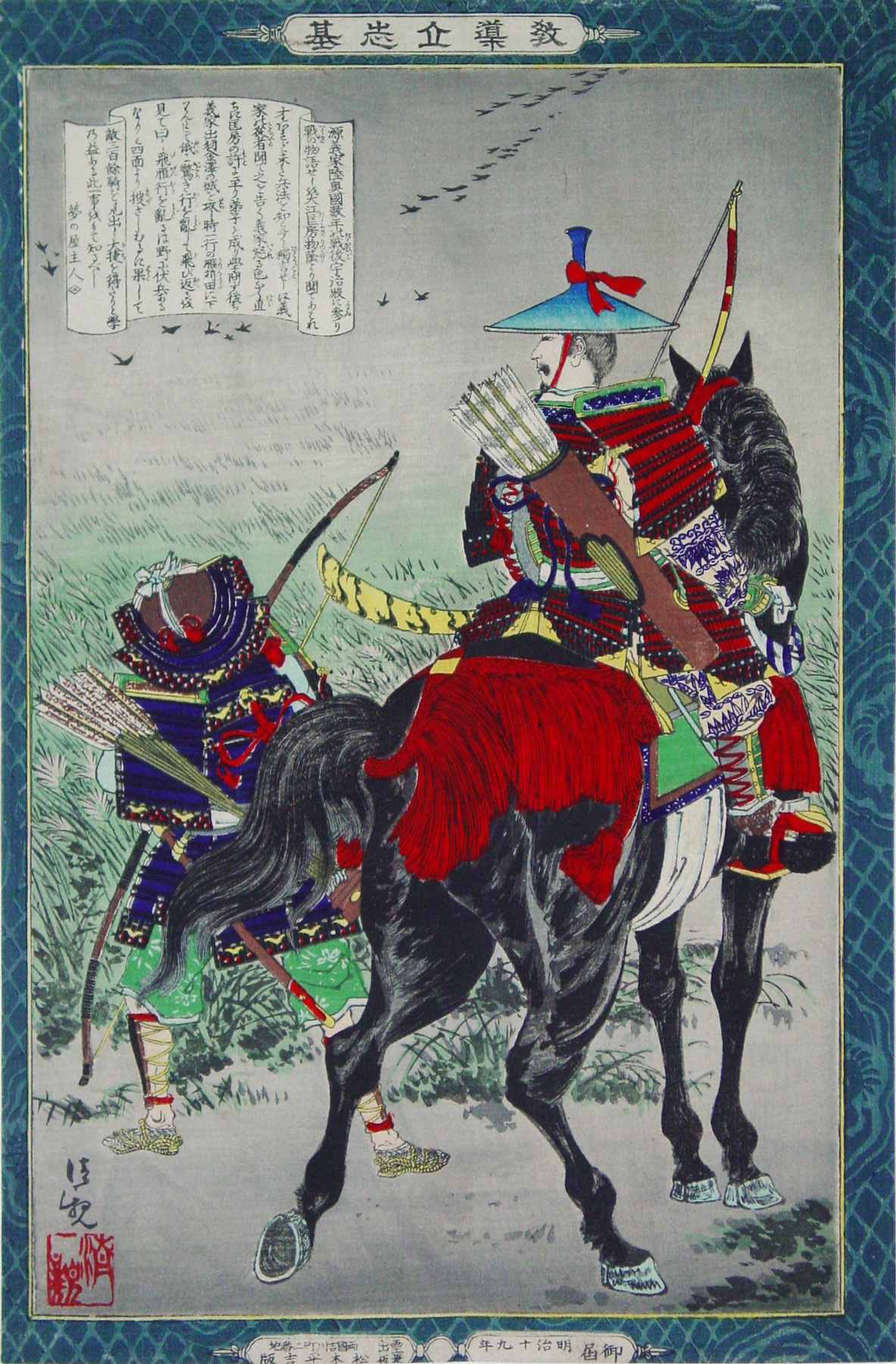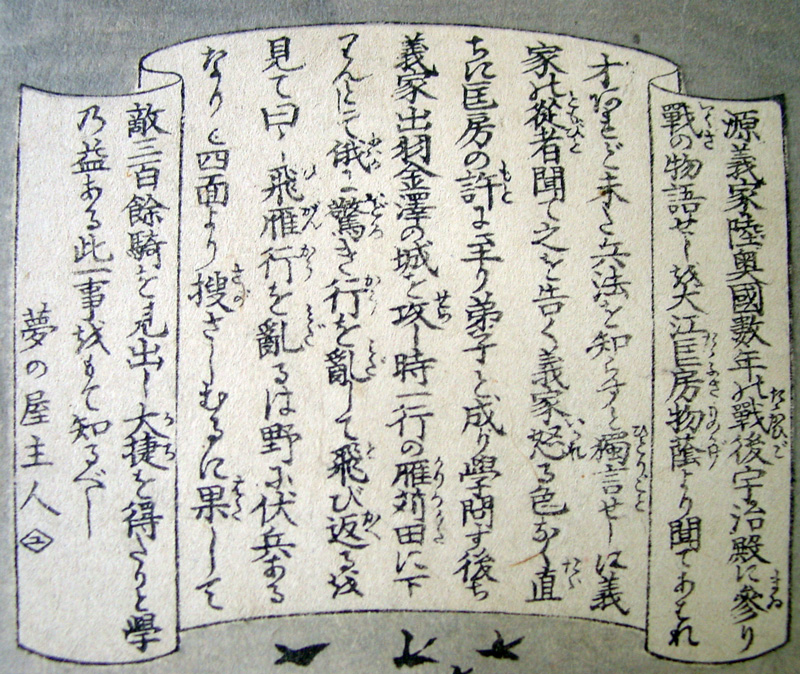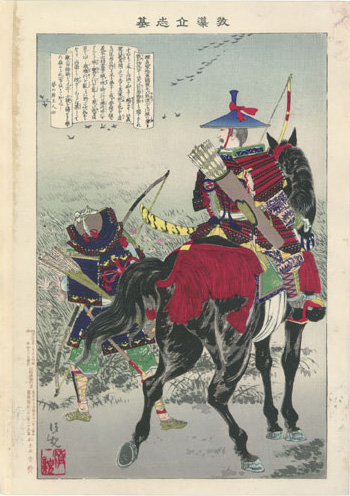About This Print
Print number 七 (7)1 in the series Instructive Models of Lofty Ambition picturing the 11th century samurai, and famed archer, Minamoto no Yoshiie 源義家 on horseback noticing the activity of a flock of geese who have been disturbed by the presence of enemy troops.Kiyochika contributed 20 prints to this series. As Smith states: "Thestyle of Kiyochika’s offerings to Instructive Models of LoftyAmbition was decorous and even stiff, as befitted the didacticemphasis of the whole [series.]"2
1 Numbering of the prints was haphazard during the production of the series. Print numbers were sometimes inadvertently omitted; some prints in the series were never assigned numbers and a few of the same numbers appear on different prints.
2 Kiyochika Artist of Meiji Japan, Henry D. Smith II, Santa Barbara Museum of Art, 1988, p. 74.
| One of the most famous stories about Yoshiie in Ōshū concerns an incident that supposedly occurred as he led his army toward Kanazawa Stockade in what became the final battle of the Later Three Years War. As the army approaches the stockade, Yoshiie sees a flock of geese rise from a field of grass and scatter. Surmising that enemy soldiers hiding in the grass have disturbed the geese, he sends men to investigate. More than thirty of the enemy are driven out of the grass and promptly put to death. Yoshiie later reflects that study of Ōe no Masafusa's book on military strategy informed him that "when soldiers conceal themselves in the grasses of plains, they disturb flocks of geese." Yoshiie's followers are impressed and grateful that their lord is so learned in the art of war. |
Minamoto no Yoshiie
Source: The Samurai Archives SamuraiWiki http://wiki.samurai-archives.com/index.php?title=Minamoto_YoshiieMinamoto Yoshiie (1041-1108), a man who came to embody the spirit of the samurai and a legend even in his own time, was the son of Minamoto Yoriyoshi (995-1082). Yoriyoshi, the third generation of the Seiwa Genji, was a noted commander, and in 1051 was commissioned to defeat the rebellious Abe family of Dewa Province. The Abe had for years held prominent posts in this distant, forbidding region, and had come to assume a certain autonomy. Like Taira Masakado, the Abe had been tasked with subduing the northern barbarians, and, from the Court’s point of view, become barbarians themselves. They were in fact described as ebisu, a somewhat generic term which was also applied to the Ainu.
Yoriyoshi’s chief opponent was Abe Yoritoki, an unscrupulous character who died of an arrow wound in 1057. By this point in the so-called Former Nine-Years War, Yoriyoshi’s son Yoshiie had joined the expedition. A promising young warrior, Yoshiie participated in the Battle of Kawasaki (later in 1057) against Yoritoki’s heir Sadato. In a snowstorm, the Minamoto assaulted Sadato’s stronghold at Kawasaki and were driven back; in the course of the hard-fought retreat Yoshiie distinguished himself and earned the nickname ‘Hachimantaro’, or ‘First son (or First born) of the God of War (Hachiman)’. Abe Sadato comes across as an altogether more impressive man than his father, and proved a formidable foe even for Yoshiie and Yoriyoshi. Yet the Minamoto cause was much assisted by the enlistment of Kiyowara Noritake, a locally powerful figure whose rugged northern men swelled Yoriyoshi’s ranks.
In 1057 the fighting culminated in a series of actions that further enhanced Yoshiie’s reputation. Sadato had attacked the Minamoto troops but suffering a reverse retreated into a fort by the Koromo River. Yoriyoshi ordered a spirit assault on the fort, which Sadato was forced to flee. During the chaotic retreat, Yoshiie was supposed to have chased Sadato and had an impromptu renga (linked verse) session with his enemy from horseback, afterward allowing him to escape. The probability that the incident actually occurred is next to nil, but it made Yoshiie seem all the more colorful, and gave him an opponent worthy in both warfare and culture. In fact, the war was nearly over. Sadato continued his flight until he reached another fort, this one on the Kuriyagawa, and prepared for another stand. The government troops arrived and after a few days of fighting brought the fort down. Sadato and his son died, and his brother Muneto was captured. Yoshiie gave thanks to his namesake by establishing the Tsurugaoka Hachiman shrine near Kamakura on the way back to Kyoto. Yoriyoshi was awarded the governorship of Iyo Province for his services against the Abe while Yoshiie was named Governor of Mutsu. Interestingly, Abe Muneto was released into the custody of the Minamoto and lived in Iyo, becoming a companion of Yoshiie’s. In 1082 Yoriyoshi died.
In 1083 Yoshiie was commissioned by the Court to subdue another rebel, this time against the same Kiyowara family who had assisted the Minamoto in the previous war. After the Abe’s defeat, the Kiyowara had been elevated and filled the power vacuum in the north. A power struggle had broken out among various family members, and in the end Yoshiie was sent to quell the disturbance. The conflict became known as the Later Three-Year War and culminated, after a setback at Numu (1086), in the Battle of Kanazawa. In an incident that became a famous military anecdote, Yoshiie’s men were advancing to contact when a flock of birds began to settle in a certain spot then abruptly flew off. Yoshiie suspected an ambush and had the place surrounded, sure enough revealing the enemy army. Yoshiie went on to reduce Kanazawa through siege and the Later Three-Year War drew to a close. The Court was pleased that the Kiyowara had been suppressed, but viewed the conflict as outside the Court’s responsibility, as technically Yoshiie had not been commissioned by the emperor to fight. This meant that no rewards would be distributed to Yoshiie’s men, an unfortunate situation Yoshiie remedied by paying them himself with his own lands. This action greatly enhanced Yoshiie’s reputation and also secured lasting bonds of loyalty for the Minamoto in the Kanto region, bonds that would pay dividends in the following century.
Stinginess aside, the aristocracy held Yoshiie in near-awe, and Fujiwara Munetada dubbed him ‘The Samurai of the greatest bravery under heaven.’ At the same time, the Court kept Yoshiie at arm’s length. It did go so far as permitting Yoshiie to visit the Imperial Court in 1098; a rare honor that by it’s very rareness indicates the widening gulf between the Court and provincial houses. This alienation would in the end contribute to the eclipse of Imperial authority by the samurai in the later 12th Century.
Shrouded in mystery, elevated to an almost godlike status in the old chronicles, it is difficult to place Minamoto Yoshiie in a historical context. His greatest political contribution was probably in strengthening the Minamoto family, especially those branches residing in the Kanto. His other contribution was less tangible. The legend of Minamoto Yoshiie, who emerged from his northern wars and the chronicles as a cultured man of war, established a model for future samurai that would influence generations of warriors to come.
Scroll Detail
click to enlarge
please feel free to translate the scroll into English and share with me at ihl@myjapanesehanga
Transcription of Scroll
Source: with thanks to Yajifun http://yajifun.tumblr.com/7 Minamoto no Yoshiie 源義家
教導立志基 七 源義家 小林清親 1886年
Transcription: [scroll text by 夢の屋主人]
“源義家陸奥國數年の戰後宇治殿に参り戰の物語せしを大江匡房物蔭より聞て あはれ才あれど未だ兵法を知らず と獨言せしに義家の従者聞て之を告ぐ 義家怒る色なく直ちに匡房の許に至り弟子と成り學門す 後ち義家出羽金澤の城を攻し時一行の雁苅田に下りんとして俄に驚き行を亂して飛び返るを見て曰く 飛雁行を亂るは野に伏兵あるなり と四面より捜さしむるに果して敵三百餘騎を見出し大捷(かち)を得たりと 學乃益ある此一事をもて知るべし 夢の屋主人”
Jim Dwinger, in his incisive article on this series appearing in the journal Andon, identifies the writer of this scroll as the news reporter Fukuichi Gen'ichirō, writing under the pseudonym Yume no Ya Shujin, who himself was subject of a print in this series by Kobayashi Kiyochika (1847-1915) titled, Fukuchi Gen’ichirō.3
Later Reissue of 1902 with border removed
About The Series "Kyōdō risshi no motoi"
Notes:
1. This series is variously translated as "Instructive Models of Lofty Ambition," "Foundations of Learning and Achievement," "Foundation of Instruction and Perseverance," "Self-Made Men Worthy of Emulation," "Paragons of Instruction and Success," "Moral of Success," "Examples of Self-Made Leaders," and "Instruction in the Fundamentals of Success." The title in Japanese is sometimes seen as "Kyōdō risshiki or "Kyōdō risshi no moto," in addition to the most commonly seen transliteration of "Kyōdō risshi no motoi".
2. For a complete listing of all the prints in the series and additional information please see the article on this site titled Instructive Models of Lofty Ambition.
This series ran between October 1885 and November 1890 and featured a long list of heroes and heroines, from antiquity to contemporary times, who were regarded as standards of moral leadership and self-realization.
Source: Kiyochika Artist of Meiji Japan, Henry D. Smith II, Santa Barbara Museum of Art, 1988, p. 74-75; original research and as footnoted.
This series of 58 prints,1 plus a table of contents sheet (目録), were originally published between October 1885 and November 1890 by the Tokyo publisher Matsuki Heikichi 松木平吉.2 The table of contents sheet issued by the publisher states that "fifty prints make up the complete set (五十番揃)". Three prints not in the initial release were added over the five year publication period, as were five redesigns of original prints, eventually increasing the total print count to 58. The seven artists contributing prints were Kobayashi Kiyochika (1847-1915) [20 prints], Mizuno Toshikata (1866-1908) [16 prints], Inoue Tankei (Yasuji) (1864-1889) [13 prints], Taiso (Tsukioka) Yoshitoshi (1839-1892) [5 prints], Yōshū Chikanobu (1838-1912) [2 prints], Toyohara Kunichika (1835–1900) [1 print], and Hachisuka (Utagawa) Kuniaki II (1835-1888) [1 print]. All the artists, with the exception of Yōshū Chikanobu, are listed in the top scroll of the table of contents sheet. Various colors (including blue, blue/green, and tan/brown) were used for the decorative border, and in 1902 the series was re-issued by Matsuki without borders.
This series of 58 prints,1 plus a table of contents sheet (目録), were originally published between October 1885 and November 1890 by the Tokyo publisher Matsuki Heikichi 松木平吉.2 The table of contents sheet issued by the publisher states that "fifty prints make up the complete set (五十番揃)". Three prints not in the initial release were added over the five year publication period, as were five redesigns of original prints, eventually increasing the total print count to 58. The seven artists contributing prints were Kobayashi Kiyochika (1847-1915) [20 prints], Mizuno Toshikata (1866-1908) [16 prints], Inoue Tankei (Yasuji) (1864-1889) [13 prints], Taiso (Tsukioka) Yoshitoshi (1839-1892) [5 prints], Yōshū Chikanobu (1838-1912) [2 prints], Toyohara Kunichika (1835–1900) [1 print], and Hachisuka (Utagawa) Kuniaki II (1835-1888) [1 print]. All the artists, with the exception of Yōshū Chikanobu, are listed in the top scroll of the table of contents sheet. Various colors (including blue, blue/green, and tan/brown) were used for the decorative border, and in 1902 the series was re-issued by Matsuki without borders.
Brief texts contained within a scroll-like cartouche appearing on each print provide historical details. The scroll composer's name is given at the end of the scroll text. The “lofty ambition” of the title is a Confucian concept, originally from Mencius, meaning “righteous determination that would inspire others.” The market for the series probably included former samurai, ambitious youth, and conservative intellectuals.
"[W]hen it was completed in 1890 the publisher was singled out for special recognition by the government for having sponsored such noble subject matter."3
1 The Tokyo Metropolitan Library online collection shows 50 prints and a Table of Contents sheet. The Table of Contents lists the titles of 50 prints. Smith in Kiyochika Artist of Meiji Japan identified 52 prints. I have identified 58 prints from this series including five prints (Ikina, Michizane Sugiwara, Kesa Gozen, Soga Brothers and Hokiichi Hanawa) that were re-designed and re-printed, likely due to damaged or lost blocks.
2 Robert Schaap notes in Appendix II, p. 166 of Yoshitoshi, Masterpieces from the Ed Freis Collection, Chris Uhlenbeck and Amy Reigle Newland, Hotei Publishing, 2011 that the series originally appeared as newspaper supplements.
3 "Positive Perceptions of Tokugawa Rule in Meiji Prints," Jim Dwinger, appearing in Andon 109, Journal of the Society for Japanese Arts, 2020, p. 11.
3 The World of the Meiji Print: Impressions of a New Civilization, Julia Meech-Pekarik, Weatherhill, 1986, p. 122.
3 The World of the Meiji Print: Impressions of a New Civilization, Julia Meech-Pekarik, Weatherhill, 1986, p. 122.
One of Five Prints from The Lavenberg Collection
loaned to the Portland Art Museum for the exhibition
"Legendary Samurai" September 14, 2013 to January 12, 2014
小林 清親画 教導立志基・ 源義家
Kobayashi Kiyochika
(Japanese, 1847–1915)
Minamoto Yoshiie
From Instructive Models of Lofty Ambition
1886
Color woodblock print
Lent by The Lavenberg Collection of Japanese Prints
Minamoto Yoshiie (1039–1106) learned warfare serving under hisfather, Yoriyoshi, the governor of northern Japan. As the “teeth and claws” ofthe court, they subdued the rebellious northern clans. Yoshiie, said thereports from the field, “rides like thunder, leaps like the wind, and shootsarrows like a god: he is a truly an incarnation of the divine warrior.” Fatherand son were awarded court ranks and vast tracts of land in eastern Japan,establishing a power base for the Minamoto that lasted for centuries.
In a famous episode fromYoshiie’s career, illustrated here, he was on his way to lay siege to an enemyfortress when he noticed a flock of geese suddenly rising from a field. Suspectingan ambush, he had his troops surround the area. If true, the story suggeststhat Yoshiie was familiar with Chinese writings on military strategy.Print Details
| IHL Catalog | #496 |
| Title or Description | Minamoto no Yoshiie 源義家 |
| Series | “Instructive Models of Lofty Ambition” (Kyodo risshiki 教導立志基) [note: seriestitle also listed as 'Kyodo Risshi no Moto', ‘Kyodo risshi no motoi’,‘Kyōdō risshi ki’ and variously translated as “Moral of success” or“Foundations of learning and achievement” or “Self-made Men Worthy ofEmulation”' or “Examples of Self-made Leaders” or "Paragons of instruction and success"] |
| Artist | Kiyochika Kobayashi (1847-1915) |
| Signature |  |
| Seal | Kiyochika 清親 below signature (as shown above) |
| Publication Date | May 1886 明治十九年 五月 |
| Publisher | Matsuki Heikichi (松木平吉) proprietor of Daikokuya Heikichi [Marks: seal not shown; pub. ref. 029] |
| Impression | excellent |
| Colors | excellent |
| Condition | good - Japanese album backing paper; borders slightly trimmed |
| Genre | ukiyo-e; rishki-e; kyōiku nishiki-e |
| Miscellaneous | print number 7 (七); position 11 in the Table of Contents for the series. Previously on loan to the Portland Art Museum for "Legendary Samurai". Portland Art Museum loan number L2013.80.3 |
| Format | vertical oban |
| H x W Paper | 13 3/4 x 9 in. (34.9 x 22.9 cm) |
| H x W Image | 12 1/2 x 8 1/4 in. (31.8 x 21 cm) area inside brocade border |
| Literature | "Positive Perceptions of Tokugawa Rule in Meiji Prints," Jim Dwinger, appearing in Andon 109, Journal of the Society for Japanese Arts, 2020, p. 10 |
| Collections This Print | Tokyo Metropolitan Library 280-K036; Smithsonian National Museum of Asian Art S1995.116.7 (green border) |




